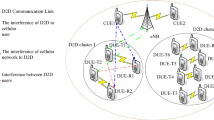Abstract
In this paper, we construct a practical framework for efficiently allocating long term evolution (LTE) resource blocks (RB) among the users in a device-to-device (D2D) network. For such network that presumably operates under the LTE cellular network, our aim is to improve the overall throughput of D2D connections using opportunistic or fairness-based approach. Taking the practical considerations into account, our proposed framework allows a number of connections to share a single RB whenever possible, thus utilizing the radio resources. To do so, our solution first identifies a superior set of the interference-free D2D reuse groups via graph modeling and graph coloring approach. In particular, we model a D2D network with a two-overlapping disk graph for which a suitable coloring algorithm is proposed and its performance bound is calculated. Once the reuse groups are known, our solution optimizes the RB allocation among these groups based on their reported channel condition as well as the scheduling criterion, whether it is fairness-based or opportunistic. Through numerical experiments, we show that our solution can significantly improve the throughput performance of a D2D network.














Similar content being viewed by others
References
Long Term Evolution (LTE). (2010). A technical overview. Schaumburg, IL: Motorola Inc., Technical White Paper. (Online). Available: http://www.motorola.com/Business/US-EN/Business+Product+and+Services/LTE.
3GPP TR 36.814 V1.2.1. (2009). Further advancements for EUTRA: Physical layer aspects, Tech. Specification Group Radio Access Network Rel. 9, June 2009.
Janis, P., Yu, C.-H., Doppler, K., Ribeiro, C., Wijting, C., Hugl, H., et al. (2009). Device-to-device communication underlaying cellular communications systems. International Journal of Communications, Network and System Sciences, 3, 169–178.
Erlebach, T., & Fiala, J. (2002). On-line coloring of geometric intersection graphs. Computational Geometry Theory Application, 23, 243–255.
Yu, C.-H., Tirkkonen, O., Doppler, K., & Ribeiro, C. (2009). Power optimization of device-to-device communication underlaying cellular communication. In Proceedings of the IEEE international conference on communications (ICC), June.
Zulhasnine, M., Huang, C., & Srinivasan, A. (2010). Efficient resource allocation for device-to-device communication underlaying LTE network. In IEEE 6th international conference on wireless and mobile computing, networking and communications (WiMob), October.
Wang, B., Chen, L., Chen, X., Zhang, X., & Yang, D. (2011). Resource allocation optimization for device-to-device communication underlaying cellular networks. In Proceedings of the IEEE vehicular technology conference (VTC), May.
Zheng, K., Hu, F., Xiangy, W., Dohler, M., & Wang, W. (2012). Radio resource allocation in LTE-advanced cellular networks with M2M communications. IEEE Communications Magazine, 50(7), 184–192.
Bennis, M., Middleton, G., & Lilleberg, J. (2008). Efficient resource allocation and paving the way towards highly efficient IMT-advanced systems. Wireless Personal Communication, 45, 465–478, June (Online). Available: http://dl.acm.org/citation.cfm?id=1363306.1363331.
Wu, Y., Keally, M., Zhou, G., & Mao, W. (2009) Traffic-aware channel assignment in wireless sensor networks. In Proceedings of the 4th international conference on wireless algorithms, systems, and applications (pp. 479–488). ser. WASA’ 09. Berlin: Springer.
Fan, Z. (2008). Wireless network access. UK Patent GB2465756, November.
Necker, M. C. (2009). Method for reducing interference in a cellular radio communication network, corresponding interference coordinator and base station. US Patent 20090081955, March.
Cao, G., Yang, D., An, R., Ye, X., Zheng, R., & Zhang, X. (2011). An adaptive sub-band allocation scheme for dense femtocell environment. In IEEE wireless communication and networking conference, March.
Horneman, K., Yu, L., & Vinh Van, P. (2011). Use of off period of DRX for direct peer to peer communication in a cell. Application number: 13/062,230. Publication number: US 0237231 A1.
Marathe, M., Breu, H., Hunt, H. B., Ravi, S. S., & Rosenkrantz, D. J. (1995). Simple heuristics for unit disk graphs. Networks, 25, 59–68.
Erlebach, T., Jansen, K., & Seidel, E. (2001) Polynomial-time approximation schemes for geometric graphs. In Proceedings of the twelfth annual ACM-SIAM symposium on discrete algorithms (pp. 671–679). ser. SODA’ 01. Philadelphia, PA, USA: Society for Industrial and Applied Mathematics. (Online). Available: http://dl.acm.org/citation.cfm?id=365411.365562.
Couture, M., Barbeau, M., Bose, P., Carmi, P., & Kranakis, E. (2007). Location oblivious distributed unit disk graph coloring. In Proceedings of the 14th international conference on structural information and communication complexity (pp. 222–233). Berlin: Springer.
Matula, D. W., & Beck, L. L. (1983). Smallest-last ordering and clustering and graph coloring algorithms. Journal of ACM, 30(3), 417–427, July (Online). Available: http://doi.acm.org/10.1145/2402.322385.
Caire, G., Muller, R., & Knopp, R. (2007). Hard fairness versus proportional fairness in wireless communications: The single-cell case. IEEE Transations on Information Theory 53(4), 1366–1385.
Jain, R., Chiu, D.-M., & Hawe, W. (1998). A quantitative measure of fairness and discrimination for resource allocation in shared computer systems. CoRR, vol. cs.NI/9809099.
Chu, D. (1972). Polyphase codes with good periodic correlation properties (corresp.). IEEE Transformaions on Information Theory, 18(4), 531–532.
Author information
Authors and Affiliations
Corresponding author
Rights and permissions
About this article
Cite this article
Hajiaghayi, M., Wijting, C., Ribeiro, C. et al. Efficient and practical resource block allocation for LTE-based D2D network via graph coloring. Wireless Netw 20, 611–624 (2014). https://doi.org/10.1007/s11276-013-0626-5
Published:
Issue Date:
DOI: https://doi.org/10.1007/s11276-013-0626-5




